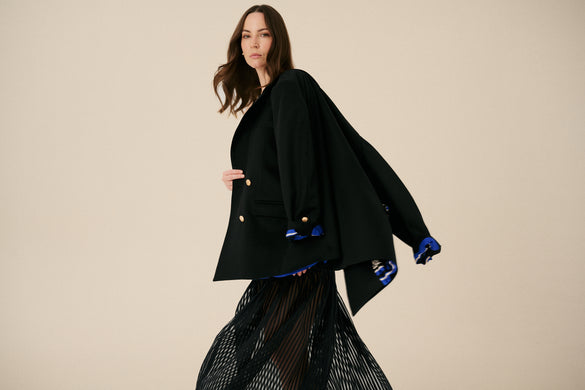THE IMPACT OF THE KIMONO ON THE WESTERN FASHION INDUSTRY

The kimono, a traditional Japanese garment, has fascinated for centuries with its elegance, minimalism, and extraordinary symbolism. It's no surprise, then, that this classic garment has found a special place in the hearts and minds of Western fashion designers. Here are a few reasons why the kimono, and the broader Japanese aesthetic, continues to inspire the Western fashion market and became the foundation for the NUES Warsaw brand!
1. Minimalism and simplicity - harmony of form and function
One of the main elements that attract designers to kimonos is their simplicity and purity of form. Unlike many Western garments, which often focus on complex cuts and embellishments, kimonos are characterized by minimalist design. They consist of simple, flat pieces of fabric that create a harmonious whole. This aspect of Japanese clothing fits perfectly into the minimalist trend, which has gained popularity in Western fashion, offering an alternative to opulence and excess. When designing collections for NUES, I also draw heavily on the comfort that minimalist clothing offers women. This gives me ample scope for experimenting with fabrics, which, given the simplicity of the cut, can be more sophisticated. This allows me to achieve a balance of comfort and the "wow factor" in each NUES design.
2. Balance between tradition and modernity
The kimono is not only a traditional garment, but also a symbol of Japanese culture and aesthetics. Its historical role and rich symbolism fascinate designers, who strive to combine tradition with modern trends. This fusion is evident in numerous collections, where classic kimono cuts are combined with modern materials and techniques, creating innovative and unique designs. This approach guides me in the design of each kimono or other garment at NUES, which at NUES invariably references this traditional Japanese garment. By combining the conservative and traditional with the modern and unconventional, I achieve extraordinary results.
3. Symbolism and Textile Art
Kimonos are not just clothing, but also a canvas for artistic expression. Rich patterns and motifs, often inspired by nature, hold profound symbolic meaning. Motifs like cherry blossoms, cranes, or waves can tell stories, convey emotions, or refer to specific seasons. When designing kimonos for NUES, I often choose fabrics with motifs of Japanese fauna, flora, or even architecture. I pay attention to the symbolism of patterns and colors. I draw on this symbolism to create collections for NUES that are not only aesthetically beautiful but also full of meaning and emotion.
4. Universality and Adaptability
Despite its traditional nature, the kimono is incredibly versatile and easily adaptable. It can be worn in a variety of ways, adapting to different occasions and conditions. This flexibility is particularly attractive to Western designers, who can freely experiment with this style, adapting it to contemporary trends and market needs. NUES is no exception. Since its inception, a brand truly "kimono," I have been proving to you that the kimono is the most versatile, comfortable, and multifunctional garment, a cornerstone of a modern capsule wardrobe.



